Episode 104 Show Notes
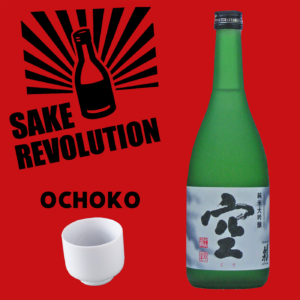 Episode 104. Week in and week out, our standard gear for tasting and evaluating sake is a simple wine glass. This works really well and almost everybody has one nearby. But in Japan, there are a wide variety of shapes, materials and sizes used to make cups for drinking sake. That got us wondering if we should take some other cups out for a test drive and compare them to our usual stemware. This week we are exploring the most common and widely used sake cup: the work-a-day ochoko. Ochokos are small, standard sake cups most often made of ceramic, but also coming in metal, glass and even wooden varieties. These cups can be seen dotting izakaya tables across Japan and are an everyday staple for sake lovers around the world. But how do ochoko stack up against our trusty wine glass? Listen now to our second sake vessel smackdown! #sakerevolution
Episode 104. Week in and week out, our standard gear for tasting and evaluating sake is a simple wine glass. This works really well and almost everybody has one nearby. But in Japan, there are a wide variety of shapes, materials and sizes used to make cups for drinking sake. That got us wondering if we should take some other cups out for a test drive and compare them to our usual stemware. This week we are exploring the most common and widely used sake cup: the work-a-day ochoko. Ochokos are small, standard sake cups most often made of ceramic, but also coming in metal, glass and even wooden varieties. These cups can be seen dotting izakaya tables across Japan and are an everyday staple for sake lovers around the world. But how do ochoko stack up against our trusty wine glass? Listen now to our second sake vessel smackdown! #sakerevolution
Skip to: 00:19 Hosts Welcome and Introduction
Welcome to the show from John and Timothy
Skip to: 02:01 Sake Vessels: Ochoko
What is an Ochoko?
An “ochoko” could most easily be defined as a small sake cup. Often, they are smaller in size and generally have smooth sides. Ochokos can be made out of many materials including: ceramic, metal, glass and wood/lacquer. It’s not an exaggeration to say that this is the most common type of sake cup.
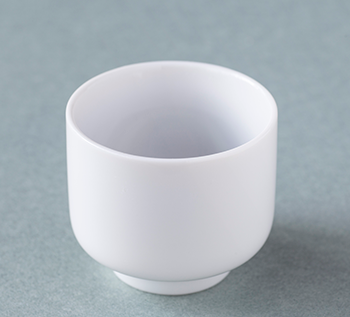
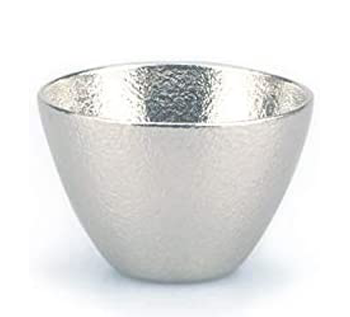
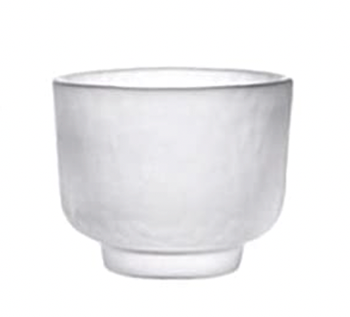
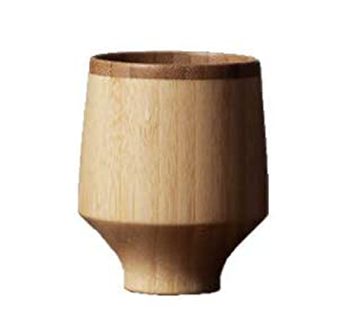
Download our Sake Vessel Cheat sheet:
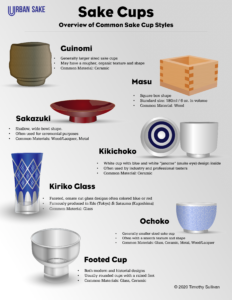
Skip to: 11:52 Sake Introduction and Tasting: Horaisen KU Junmai Daiginjo
Horaisen KU Junmai Daiginjo
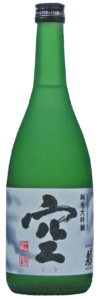
Brewery: Sekiya Jozo
Prefecture: Aichi
Classification: Junmai Daiginjo
Seimaibuai: 40%
Alcohol: 15.0%
Brand: Houraisen/Horaisen (蓬莱泉)
NOTE: Use Discount Code “REVOLUTION” for 10% off your first order with Tippsy Sake.
Skip to: 27:26 Show Closing
This is it! Join us next time for another episode of Sake Revolution!
Support us on Patreon
 Now there is a new way to support Sake Revolution. Join us on Patreon! Patreon is an online platform that allows you to support your favorite creators by subscribing to a monthly membership. At Sake Revolution, we’re offering two tiers, each with its own perk. If you enjoy our sake podcast, if you are able, please consider supporting this labor of sake love! See below to learn about our Patreon support levels.
Now there is a new way to support Sake Revolution. Join us on Patreon! Patreon is an online platform that allows you to support your favorite creators by subscribing to a monthly membership. At Sake Revolution, we’re offering two tiers, each with its own perk. If you enjoy our sake podcast, if you are able, please consider supporting this labor of sake love! See below to learn about our Patreon support levels.
-
Sake Enthusiast
Have you ever wanted to sip along with us as we taste our sakes on the podcast? Now you can! As a Sake Enthusiast patron, you’ll get the inside track and know in advance which sakes we’ll be featuring on the show. This allows you to get them on hand and sip along with us while you listen.
-
Sake Otaku
As a Sake Otaku supporter of the pod, you’ll get access to all the Sake Enthusiast intel along with access to a monthly live zoom Sake Happy Hour taking place the first Weds of every month at 9pm ET (6pm PT). Visit with us live on zoom! Come with all your questions and suggestions and enjoy a relaxed and fun Happy Hour with with us as we all sip sake together!
Episode 104 Transcript
John Puma: 0:22
Hello everybody. And welcome to Sake Revolution. This is America’s very first sake podcast and I am one of your hosts. And my name is John Puma from the Sake Notes. You may also know me as administrator at the internet sake discord, uh, where we encourage people to come and join our little community and chat about sake together.
Timothy Sullivan: 0:46
And I am your host, Timothy Sullivan. I am a Sake Samurai. I’m a sake educator, as well as the founder of the Urban Sake website. And every week, John and I will be here tasting and chatting about all things, sake and doing our best to make it fun and easy to understand. Hey John, how you doing?
John Puma: 1:06
I am doing quite well. How about you tim? Good. A good week. So far
Timothy Sullivan: 1:10
Yeah, really good week. I’m ready for another fun sake episode, and we are going to be talking about sake vessels again, another one of our series.
John Puma: 1:22
yeah. Yeah. So let me just go and grab my wine glass.
Timothy Sullivan: 1:25
no. no. Get back here.
John Puma: 1:28
Wait, but
Timothy Sullivan: 1:29
No, no, we wait, wait a minute, John. we do, we do use a wine glass.
John Puma: 1:34
we do,
Timothy Sullivan: 1:35
We recently did a sake vessels episode featuring the traditional Uber traditional sakazuki,
John Puma: 1:43
Yes.
Timothy Sullivan: 1:44
the ceremonial sake cup. But today we’re going to keep it much more down to earth and much more real.
John Puma: 1:49
Oh, so there’s going to be a little bit fewer weddings and yakuza.
Timothy Sullivan: 1:54
There’s less pomp and circumstance
John Puma: 1:57
Oh,
Timothy Sullivan: 1:58
episode.
John Puma: 2:00
Good to know. Good to know.
Timothy Sullivan: 2:01
Yeah. we are keeping it super basic. And this week we’re going to talk about the all-purpose ochoko I’m sure you’ve heard this term before. Ochoko
John Puma: 2:17
Yeah.
Timothy Sullivan: 2:17
the honorific. So you can say, O-choko, or you can say choko if you’re being a little more casual.
John Puma: 2:23
Um, but you should, you should respect the choko. So, Ochoko.
Timothy Sullivan: 2:28
Ochoko
John Puma: 2:28
always, yeah, for me, it’s always been, I’ve always focused my mind when I think of it. It’s ochoko right. When I see the object, the name that pops into my head. ochoko. Now, for those at home who are not familiar, Timothy, what should people be on the lookout for when they’re trying to find. The ochoko, how do they know what it is?
Timothy: 2:51
Well, ochoko just means sake cup. it is the most general all-purpose term you can use for sake cup.
John Puma: 2:59
oh wow. It was easy.
Timothy Sullivan: 3:02
Yeah.
John Puma: 3:04
Uh, and I guess for the purposes of what people think of the ochoko these days,
Timothy Sullivan: 3:09
Yeah,
John Puma: 3:11
what are we dealing with?
Timothy Sullivan: 3:12
well, there’s a few characteristics. There’s no hard and fast rules, but there’s a few characteristics that I believe would define what an ochoko is versus any other type of sake cup. And the first one I really think is the most important, which is the size. But I know ochoko is generally a smaller size sake cup, uh, and I would say probably two to maybe three ounces in size, so generally smaller. And the other thing I’ve noticed about ochoko is that, they’re generally, I I’ve often seen them as having like smooth sides. So there’s some sake cups that are very. Earthen ware and very rustic and almost a crinkled in texture. And ochoko tend to be like smooth, small, very standard size sake cups, very traditional. And just what you would expect if you got a small sake cup in a restaurant,
John Puma: 4:15
Okay. All right. And, um, w what are they usually made out of like my, I get the impression from what we’re, what we’re both holding right now that like, this is usually like a ceramic kind of thing.
Timothy Sullivan: 4:27
Yeah. They’re the most basic traditional ones are usually like a white porcelain or white ceramic, but they also make them, I’ve seen, ochoko made out of metal. I’ve seen them made out of glass and even sometimes made out of wood. So any small, smooth sided, two to three ounce sake. Could be considered an ochoko it’s a general overarching term. And again, there is no real hard and fast definitions, but based on the general communal understanding, I’d say that’s a pretty good working definition for what you might want to expect with that.
John Puma: 5:04
Okay. And, uh, um, so not as much pomp and circumstances you pointed out, but when, when do you actually use the ochoko traditionally.
Timothy Sullivan: 5:14
We mentioned the size of the ochoko. They’re pretty small. So, this is not something I use too much at home by myself, or I’d be refilling my cup
John Puma: 5:26
so
Timothy Sullivan: 5:27
every
John Puma: 5:27
what you’re saying is at home, you like to, uh, serve yourself a large portion.
Timothy Sullivan: 5:32
at home. I made. I may true confession time. I may lean towards a larger size sake cup, but when you’re in a restaurant or you’re having a sake experience with friends, the ochoko is smaller. It must be refilled more often. And in Japan we’ve talked about in our sake etiquette episode, we talked about refilling other people. Glasses and not refilling your own is the polite way to interact with people over sake and these smaller ochoko cups allow for that interaction because you have to constantly keep your eye on everyone. Else’s cup, keep it filled, they’ll refill your cup, And, it gives you a chance to interact in that very Japanese way. So that’s another reason that I believe that there tend to be a little bit smaller for the standard.
John Puma: 6:24
and if you are not familiar with what Tim is talking about, you need to go back and find episode number 82 of Sake Revolution. Uh, the episode about sake etiquette, where we talk about. All the gamesmanship around watching people’s cups and making sure that they’re never left wanting for sake. Uh, it is, it was a definitely a fun one. And you should go back and check that out if you’re not familiar
Timothy Sullivan: 6:51
Yes, you can never be too polite when it comes to sake.
John Puma: 6:55
It was the, the number one thing we came away from that episode with, I was like, well, you know, it can always be a little bit more on top of the pouring of sake. Uh,
Timothy Sullivan: 7:06
Now, we’ve talked about the sake Zuki before, and we’re talking about ochoko today. Now, if you’d like an overview of all the major styles of sake cups, you can visit our website, sakerevolution.com, and we put together a cheat sheet for you. Of all the different sake cups. So if you want a visual of what we’re talking about with the sakazuki versus an ochoko versus all the other upcoming styles, check out the website and you can download the PDF for free. I, I mentioned earlier that there’s a number of materials with the white porcelain being the most common. Have you ever seen these small ochoko sake cups and other materials? Have you tried a glass one or a metal one, or even a wooden?
John Puma: 7:56
I think I used a wooden one once maybe, but, uh, definitely I’ve had some glass, uh, some glassware like that. Other types of porcelain and ceramic. Um, in fact, when we were recently in Hawaii, you can go two episodes back to here. I was talking a little bit about when, when John and Myshell were in Hawaii, uh, we also picked up some sake cups, some ochoko from the sake shop that were actually made by local Hawaiian artisans and they are all very unique and very different. And they’re really, really nice, a really nice cups and we enjoy using them all the time here. Uh, but as Tim pointed out earlier, uh, at home, you know, the, the ochoko is a little bit small. So what we usually do is we’ll pour the sake into a carafe and then, and then poured into our, into our ochoko from there.
Timothy Sullivan: 8:50
That is a really fun way to drink sake at home too, is to have the carafe. So that’s your larger portion that you’re probably going to end up drinking. And then if you have a small cup, you just pour a bit by bit as you enjoy your Netflix or whatever, and it is a wonderful way to enjoy sake at home. So in that way, ochoko is a real. Really practical way to drink. And if you have sake warmed or chilled, the smaller, you know, two ounce cup is going to hold your sake at temperature better because it’s a smaller sized cup. That’s another advantage of this. ochoko that’s why I think it’s really safe to say that ochoko is just your all purpose every day, small Swiss army knife, sake cup. know, it is all purpose and you can use it in almost any circumstance.
John Puma: 9:49
Nice. when you were mentioning other materials, Uh, you mentioned glass. Did you, did you actually, did I hear that right? Did you mention metal?
Timothy Sullivan: 9:56
Yes.
John Puma: 9:57
Tell me more about the metal. I, I’ve kind of interested in this.
Timothy Sullivan: 10:01
Yes. There are ochoko made out of metal Sterling silver for very high-end fancy sakes sets. But a more common metal is tin. So there is a hammered tin and very skilled production of metal. And in Niigata there’s a very famous region that does a stainless steel production and they make very beautiful metal ochoko that are crafted out of stainless steel. So basically all kinds of metals that are good for drinking out of, you can find ochoko in all of these metals. And the one thing I love about drinking out of a metal ochoko like a stainless steel one is that it really maintains the cold. So pour a chilled sake into a stainless steel ochoko, it really maintains the cold. Feel it with your hands and it chills the cup. So pre-chilling those metal cups and drinking cold sake out of it in the summer is the best.
John Puma: 11:10
That sounds really nice. Well,
Timothy Sullivan: 11:13
Yeah.
John Puma: 11:13
summer is
Timothy Sullivan: 11:14
Yes
John Puma: 11:15
I need to get a metal ochoko.
Timothy Sullivan: 11:17
you do. And the glass ones are fabulous too, because you can see through them. And sometimes they have different colored glass and you can see a different design through it. But if you like looking at the color of your sake and using clear glass ochoko is beautiful. And again, the clear glass and the metal I would say are more for chilled sake and the porcelain earthenware and ceramic are really good for chilled or for warm sake. They do a great job of insulating keeping sake warm.
John Puma: 11:52
so Tim, we’re going to be pouring some sake into our ochokos and also, you know, the, the tried and true wineglass. And we’re going to do a little compare and contrast about the experience. and this week’s sake is a Sekiya Hourisen. And this is a Junmai Daiginjo from Sekiya Jozo in Aichi Tim. I don’t think we to be represented Aichi very often on the show have we?.
Timothy Sullivan: 12:22
Aichi power. about time.
John Puma: 12:27
The, um, classification on this of course, is that you might like Daiginjo the Seimaibuai, that rice milling percentage is down to 40%, so.
Timothy Sullivan: 12:37
Oh,
John Puma: 12:38
solid junmai Daiginjo territory.
Timothy Sullivan: 12:40
can feel the luxury.
John Puma: 12:42
Yeah. Um, the alcohol percentage is 15 even, and I don’t see the rice type, unfortunately.
Timothy Sullivan: 12:52
Yeah, I scoured the interwebs and the acidity, the SMV and the rice type. are N/A. So they are not announced by the brewery.
John Puma: 13:04
that, that, that happens that does
Timothy Sullivan: 13:05
It does happen, but something tells me we’re still going to enjoy it.
John Puma: 13:11
Um, I think I have that same thought. Um,
Timothy Sullivan: 13:15
Yeah. So Horaisen brand is really well-known in Aichi and the Sekiya brewery is known for making very delicious, small batch brewed sakes. So I’m super excited to try this one. And this brewery was founded in 1864.
John Puma: 13:37
Uh, all right. 1864 us. They are, they’ve been doing this for a while. Like, like many Japanese breweries. They’ve been doing this for quite a bit. Love it. Um, so we’re going to pour this in both of our, in both our wine glass and in our ochoko and, uh, we’ll get right down to it. This will be the, the wine glass SmackDown. Uh,
Timothy Sullivan: 14:03
yes. Just like we did with our sakazuki. We’ve got, now I have a, I have an ochoko that fits the parameters that I described. It’s about a three ounce ochoko it’s white ceramic. It is the most basic form. So, um, and you also have a white ceramic ochoko as well.
John Puma: 14:24
I do,
Timothy Sullivan: 14:25
all right. So I’ve got the Horaisen Junmai Daiginjo “Ku”, and we’re going to get this open and into our glass. Let’s go.
John Puma: 14:36
Let’s do it.
Timothy Sullivan: 14:38
All right. Let’s, let’s start with the ochoko first. think It only makes sense. The ochoko is. the guest. The ochoko was the guest on this episode.
John Puma: 14:47
is. It really is. Um, and you know, the, you know, the challenger gets introduced first, right?
Timothy Sullivan: 14:52
Yep. Okay. So, so we’re both drinking out of white porcelain ochoko and I have to say it gives me an excellent view of this sake
John Puma: 15:08
It
Timothy Sullivan: 15:10
looking, looking into the white it’s like looking at a wine glass against oh, bright, white tablecloth. It gives you the perfect view of the sake color and the color here coming through for me is exceedingly clear and transparent.
John Puma: 15:24
Yeah. Um, typically when we’re doing the show, um, and even if I’m just at home and I pour some sake into a glass, I usually hold the glass up to my, up to my monitor and compare it to like a white background of, of a document or something like that. And I try to get the weight from there, but. With the ochoko. I am, I can look down straight into it and you really get a great feel for, how clear it is against that stark white background.
Timothy Sullivan: 15:50
Absolutely. Now I filled mine about three quarters full, but this is a little bit giving me flashbacks to our sakazuki episode. I have to keep, I have to keep an eye on it. If I wiggle too much, if my hand wobbles a little bit too much, I might have a little spill. So I do have to, you know what I mean?
John Puma: 16:14
Yeah, I do, but I don’t think the situation is as dire as it was. I feel like a, a S uh, a nice breeze might have knocked sake out of, out of the
Timothy Sullivan: 16:29
Yes.
John Puma: 16:30
this, um, you know, I feel like, you know, you had a steady hand. You’re going to be okay.
Timothy Sullivan: 16:34
Yes. Yes. One steady hand. I’m just, I’m just making a note. It’s not, my attention is a little bit focused on the, the ochoko. Okay. Let’s give it a smell from the ochoko.
John Puma: 16:47
Hmm,
Timothy Sullivan: 16:48
Hm.
John Puma: 16:51
Tim, talk to me about this aroma.
Timothy Sullivan: 16:55
Well, out of the ochoko it’s very Gentle and very soft.
John Puma: 17:01
Gentle soft. Fruity.
Timothy Sullivan: 17:04
I’m getting a, an aroma of pear. I smell a little bit of pear or green apple, and maybe a hint of something steamed rice-y in the background, but very soft, very gentle, quiet.
John Puma: 17:22
Yeah.
Timothy Sullivan: 17:23
And this is the experience with the ochoko and there’s more surface area, closer to the mouth of the cup. And a lot of the volatile aroma compounds that are coming off the surface here, escape more easily into the air. So we’re not getting the concentration of aroma. So it dissipates a little bit more, but it’s still really enjoyable. What do you think.
John Puma: 17:46
I agree. it is definitely present. I have a hard time really, uh, capturing it because I have a few moments to think about it and then it’s gone. Also we can’t agitate it in this vessel very well. So one thing we like to do in the, in our wine glasses is swirling around and that releases that aroma. Um, can’t really do that. I don’t care how steady your hand is too. Uh, it’s going to, you’re going to have a mess if you do that with your ochoko.
Timothy Sullivan: 18:18
Yes. I don’t think the whole ochoko was designed with swirling in mind. Not at all.
John Puma: 18:27
Yeah.
Timothy Sullivan: 18:27
Well, let’s take a sip out of our ochoko this Junmai Daiginjo let’s give it us. Hm.
John Puma: 18:37
Hmm. You know, it may not have been designed for swirling, but it seems to be perfectly fine for sipping Tim.
Timothy Sullivan: 18:42
Yes, it’s just lovely. The, sake hits your palate at a great angle and spreads across the palate. I’m getting a little bit of creaminess and just a hint of soft rice on the palate. It’s not as fruity as the aroma. What’s what, what are you getting?
John Puma: 18:58
Yeah, the aroma led me to believe that we were going to be getting something a little bit more fruit-forward um, but this is something that we’ve spoken about before with. These daiginjos that have a more rice forward profile? It’s linke a sweet rice, I
Timothy Sullivan: 19:18
Like rice pudding.
John Puma: 19:19
yeah. Oh, wow. Yeah, that’s great. That’s yes. I surely I’m a big fan of rice puddings that, that, that puts a smile on my face also. Um, and it, and it just makes that connection. As soon as you said the words, I was like, oh, fantastic. Yes, but with a little bit more fruit to it and, and.
Timothy Sullivan: 19:36
Hm.
John Puma: 19:38
Very nice, very different. I will say that. and very tasty. but the aroma did lead me down a different path. I thought,
Timothy Sullivan: 19:47
so we don’t have an SMV number, so we’re you and I are both tasting this blind in that regard. Do you think there’s a good balance between sweet and dry here?
John Puma: 19:56
Yes, I do think it is. I it’s, it is nice and balanced. It is, you know, none of the factors are really bowling me over and, and, and stopping me from appreciating the rest of it. I’m getting to, uh, enjoy everything about this sake, you know, a little bit, uh, separately. There’s a, there’s a nice little nuance to everything I’m sitting here.
Timothy Sullivan: 20:15
Yeah. it’s a really cohesive, I find the sweetness comes forward a little bit more in the front. Like when you first sip it, you get that rice pudding. Uh, gentle fruitiness and then the finish kind of comes as a wave of dryness for me. So I’m, I would be super curious to know what the official SMV number is, but we don’t in this case.
John Puma: 20:37
Yeah.
Timothy Sullivan: 20:38
in any case, I find that it’s really balanced and cohesive. Just like you described.
John Puma: 20:43
Now let’s move over to the wine glass and see what happens. Now. This vessel, this vessel was made for swirling.
Timothy Sullivan: 20:55
I’m already swirling.
John Puma: 20:56
here we go.
Timothy Sullivan: 20:58
I’m way ahead of you. So I have this poured into my standard kind of mid-size stemmed wineglass, giving it a swirl. Now let’s give it a smell.
John Puma: 21:09
there’s a lot more truth in this aroma of the wine glass. I think
Timothy Sullivan: 21:14
Please elaborate.
John Puma: 21:16
’cause, I’m getting a lot more of the rice.
Timothy Sullivan: 21:18
Ah, okay.
John Puma: 21:19
I thought when I was sniffing it out of the ochoko, I was really getting the fruit and I missed a lot of the rice. So the rice one, the rice flavor, when it hit me in a sipping was a little bit of a surprise. In this case, with the aroma, the rice is right there in the mix with everything else. And I suspect that when we see. It’s going to be a much more, cohesive experience going from the nose to the taste. What do you think.
Timothy Sullivan: 21:49
Yeah. I, you know, thinking back to the sakazuki, that saucer like shape that we had, that was almost impossible to get any aroma. And then this one is a, little bit more of a bowl shape, and we got some of the aroma, but both of these compared to the wineglass, the wine glass, just channels that aroma right to your nose and with a swirl, it is still hard to beat.
John Puma: 22:14
Yeah.
Timothy Sullivan: 22:14
All right. Let’s give it a taste from the wineglass.
John Puma: 22:17
Let’s have a sip.
Timothy Sullivan: 22:20
Yes,
John Puma: 22:21
uh, interesting for me and this one, the rice while more prominent on the nose, a little less prominent on the palate. And maybe that’s because of the whole thing with the nose and you know, it’s not a suprise anymore
Timothy Sullivan: 22:37
Yeah. Yeah. For me, the wineglass experience feels more like the sake is hitting the center of my palate quickly. And from the ochoko it felt like it spread more across my palate. Like the, the amount of sake coming in at one time from the ochoko is spreading. And I think muting the flavor a little bit. Yeah. Uh, softening it and from the wineglass it’s flows in more quickly and hits the center of my palate very quickly. And it feels like I’m getting more of a burst of flavor. Does that make sense to you?
John Puma: 23:14
I think so. I think so. And Explains a little bit of some of the experience that I’m having. I sometimes, like I know the, what I’m experiencing. I don’t know. Always the why.
Timothy Sullivan: 23:24
Um, I would say that the the aroma, I enjoyed more from the wine glass, but the flavor, I actually enjoyed more from the ochoko because it was softer and it was more gentle and it was less kind of abrupt for me. So I really liked the slow roll of the flavors from the ochoko.
John Puma: 23:45
Interesting. And I, I understand. but, but I think for my, uh, personal style, I kind of like it a little bit more from the wineglass because, um, well, honestly I tend to go with fruit over rice and I’m getting more fruit from it from my experience when I tasted out of the, out of the wine glass.
Timothy Sullivan: 24:06
All right. Now we’ve chosen of Junmai Daiginjo to taste today. What do you think would happen if we have. Like a honjozo style sake in the same comparison. What do you think?
John Puma: 24:21
well, I think that it would probably be a lot more friendly to the ochoko. Uh, I mean, don’t get me wrong. There are plenty of very aromatic honjozos out there. But I think that when we talk about honjozos over, we’re not talking about aromatics sakes. So yeah, I do think the ochoko we’ll we’ll do some favors and it will, there’ll be much more comfortable in that glassware.
Timothy Sullivan: 24:44
So there is a place for ochokos I think with whole different grades of sakes. But the, the one that may be a little bit more appropriate for serving with an ochoko may be a bit more earthy Junmai or honjozo style that might be a good recommendation for listeners. Don’t
John Puma: 25:06
to me. Yeah. Yeah. I think that If there’s going to be a lot of, there’s going to be softness on the aroma and a lot of fruit, something of a big bouquet, your, your, your prototypical Ginjo Sake, you’re probably going to experience those aspects of the sake more out of the wine glass.
Timothy Sullivan: 25:26
Yeah. I think if one way to say this, I think is if you want to study the aroma. a wineglass is your friend,
John Puma: 25:35
I like, I like that. I like.
Timothy Sullivan: 25:36
whether you’re in a restaurant or at home, but if you’re just enjoying the sake as a whole, and you’re not there to necessarily study it or observe it at a deeper level, I really enjoyed drinking this Junmai Daiginjo, out of a no ochoko, I’m not mad about this at all. I think it’s really fun to try different vessels and different types of cups. And I am a big proponent of being flexible and trying different combinations of sakes and vessels.
John Puma: 26:07
one thing I really liked is that, you know, once again, we’re kind of having another experience where the glassware does have a big influence and we’re learning that, that the vessel that you drink, your sake out of is another, it’s another level of your sake, drinking experience. Another thing that you can play with and, and see what happens you already have different styles. You have different temperatures and now different glassware, and you can have a whole range of different flavors from your sake.
Timothy Sullivan: 26:35
the very, some of the very best sake, a forward restaurants I’ve visited in the past. That means restaurants that focus on their sake list or specialized in sake. They have a wide variety of cups and glassware and carafes, and based on their knowledge of the style of sake, they will serve you out of a certain type of glassware that they recommend for that. And that level of services really amazing. And I always, when I was first tasting sake and I went to these restaurants that really focus on sake. Oh, why did you pick this glass or that glass? And they would explain to me like, oh, well this is more earthy, less aromatic. So blah, blah, blah. And it’s really fun to learn about.
John Puma: 27:22
Uh, who knew you can drink sake out of so many different types of vessels.
Timothy Sullivan: 27:26
We’re going to have another sake vessel episode coming up soon. So stay tuned and we hope you enjoy. Thanks so much for all of our listeners for tuning in John has always, it was great to taste with you. I want to send out a special shout out to all of our patrons who support us on Patreon.com/SakeRevolution.
John Puma: 27:47
And, um, by the way, if you want to learn more about our antics and keep up with what we’re up to, uh, please check us out on social media, we’re on all the big ones, not, not no Tik TOK yet.
Timothy Sullivan: 28:00
No, comment,
John Puma: 28:01
no, no no Tik tOK just yet, but, uh, it’s kind of maybe coming soon, who knows, but, uh, Instagram, Facebook, Twitter, all of our, our favorite social media platforms. So, uh, come around and check us out. so until next time please grab your, ochoko. Remember to keep drinking sake And Kanpai.